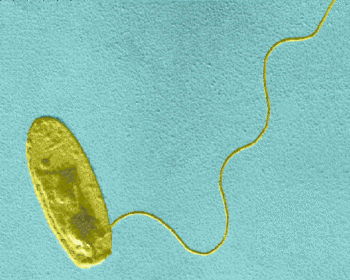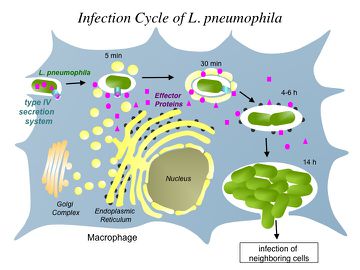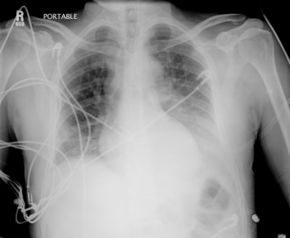Legionnaire's Disease: Difference between revisions
| Line 28: | Line 28: | ||
===Infectious Dose, Incubation, and Colonization=== | ===Infectious Dose, Incubation, and Colonization=== | ||
[[Image:patho_2.jpg|thumb| | [[Image:patho_2.jpg|thumb|360px|right|Pathogenesis of <i>L. pneumophila</i> From: National Institute of Health [http://2011annualreport.nichd.nih.gov/ump.html/]]] | ||
Although the infectious dose of Legionnaires disease is unknown, there have been many studies that have indicated that as little as one-colony, even one organism, of ''L. pneumophila'' has been thought to cause an infection in susceptible, immunocompromised people. (CDC special report). The disease is not easily spread, as it cannot be contracted through person-to-person contact. The incubation period of ''Legionella pneumophila'' that causes Legionnaires disease is approximately 2-14 days after being exposed to the pathogen. The strain of ''L. pneumophila'' that causes Pontiac Fever has an incubation period of around 30 to 90 hours. Although pontiac fever presents with much milder symptoms, those infected typically begin to experience signs of the illness much sooner than those infected with Legionnaires disease. (Canada page). Many people exposed to the pathogen, however, never experience any signs of infection due to the body's ability to fight off the pathogen so readily. | Although the infectious dose of Legionnaires disease is unknown, there have been many studies that have indicated that as little as one-colony, even one organism, of ''L. pneumophila'' has been thought to cause an infection in susceptible, immunocompromised people. (CDC special report). The disease is not easily spread, as it cannot be contracted through person-to-person contact. The incubation period of ''Legionella pneumophila'' that causes Legionnaires disease is approximately 2-14 days after being exposed to the pathogen. The strain of ''L. pneumophila'' that causes Pontiac Fever has an incubation period of around 30 to 90 hours. Although pontiac fever presents with much milder symptoms, those infected typically begin to experience signs of the illness much sooner than those infected with Legionnaires disease. (Canada page). Many people exposed to the pathogen, however, never experience any signs of infection due to the body's ability to fight off the pathogen so readily. | ||
Revision as of 15:26, 27 July 2014


Etiology/Bacteriology
Taxonomy
| Domain = Bacteria
| Phylum = Proteobacteria
| Class = Gammaproteobacteria
| Order = Legionellales
| Family = Legionellaceae
| Genus = Legionella
| Species = Legionella pneumophila
| NCBI: Taxonomy Genome: Genome |
Description
Legionnaires disease is a type of pneumonia caused by the pathogenic proteobacterium Legionella pneumophila. L. pneumophila are motile, aerobic, non-spore forming, Gram-negative rods that reside in freshwater complexes with high algae and amoeba count. [12] Transmission of the pathogen generally occurs through contaminated water droplets in the form of mist or aerosol particles. However, most people exposed to the pathogen never develop any symptoms of the disease. Those who are susceptible to the illness typically include immunocompromised patients, adults over the age of 50, and heavy smokers. Symptoms of Legionnaires are indicative of other types of pneumonia and include severe high fever, chronic cough, shortness of breath caused by a build up of fluid in the lungs, and extreme malaise. If contracted, patients are often hospitalized; however, the mortality rate is low due to the pathogen's susceptibility to fluoroquinolone antibiotics. Treatment of Legionnaires disease typically takes between 7-10 days after the initial start of antibiotic treatment; however, it has been known to take up to 21 days in immunocompromised patients. Immunocompromised infants and elderly adults should avoid public water systems that have not been properly sanitized in order to prevent contact with Legionella pneumophila.
Legionella pneumophila can also cause a much milder illness known as Pontiac Fever. Symptoms of this illness are similar to Legionnaires disease, but tend to be not as severe. Hospitalization is usually not required and symptoms usually only last around 2-5 days. There are no known antibiotic treatments for Pontiac Fever, as symptoms usually reside on their own. (CDC)
Pathogenesis
Transmission
Legionella pneumophila survive and thrive in warm, damp environments, typically those that have a high amoeba count. This includes full bodies of freshwater, soil, and various areas of fresh dirt (Australian Health Page). L. pneumophila are often spread through airborne water droplets, known as a aerosols. Optimal growth of the bacteria is 28-40°C, but the bacteria does not survive past 60°C (emedicine) Because of the high temperature in which the bacteria are able to survive, man-made public water systems such as showers, hot tubs, and fountains are the perfect place for L. pneumophila to thrive. (Australian Health Page). The transmission of the bacteria can come from a mist or vapor emitted from a fresh water system that has not been properly disinfected (CDC). The bacteria, however, cannot be spread through person-to-person contact, unlike other forms of pneumonia. (CDC) Many people that are exposed to the L. pneumophila do not develop any symptoms; therefore, those that surround an infected person in a work or school place are not at risk of developing the disease (CDC).
Infectious Dose, Incubation, and Colonization

Although the infectious dose of Legionnaires disease is unknown, there have been many studies that have indicated that as little as one-colony, even one organism, of L. pneumophila has been thought to cause an infection in susceptible, immunocompromised people. (CDC special report). The disease is not easily spread, as it cannot be contracted through person-to-person contact. The incubation period of Legionella pneumophila that causes Legionnaires disease is approximately 2-14 days after being exposed to the pathogen. The strain of L. pneumophila that causes Pontiac Fever has an incubation period of around 30 to 90 hours. Although pontiac fever presents with much milder symptoms, those infected typically begin to experience signs of the illness much sooner than those infected with Legionnaires disease. (Canada page). Many people exposed to the pathogen, however, never experience any signs of infection due to the body's ability to fight off the pathogen so readily.
Epidemiology
While Legionnaires disease can be found worldwide, the most common places for infection are the United States, Canada, Australia, parts of Asia, and Europe (science direct). There are approximately 8,000-18,000 cases of Legionnaires disease reported in the United States alone each year, and there are many cases that remain unreported. (emedicine) Although the disease can be contracted sporadically throughout the year, the peak season for the pneumonia is June-October. The humidity and warm, wet climate found in during these months tend to be optimal living conditions for L. pneumophila, causing the number of bacteria to increase (science direct). Legionellosis is known to be the cause of 5-15% of community-acquired pneumonia (e medicine). The disease usually occurs in adults over the age of 50, and the ratio of men to women affected is 4:3 (science direct).
The largest known outbreak of Legionella acquired pneumonia was in July 1976 in Philadelphia. Approximately 182 people were infected, 147 required hospitalization, and of those, 29 people died. The source of the outbreak has been linked to the cooling towers at the Bellevue Stratford Hotel. The bacteria is believed to have been colonized in the cooling towers and distributed amongst the guests at the hotel through the air conditioner units. (Pennsylvania book).
Virulence Factors
Clinical Features
Many of the symptoms of Legionnaires Disease are characteristic of pneumonia. Symptoms typically begin with a shortness of breath followed by a cough. A high fever, headaches, muscle aches, and malaise are other symptoms that occur with pneumonia caused by Legionella pneumophila. [2] Signs of symptoms can appear 2-14 days after being exposed to the pathogen. Many people that come into contact with Legionella pneumophila do not show symptoms. Legionnaires disease can be found in anyone; however, it is usually found in patients over 50, heavy smokers, and immunocompromised patients. [1]
Morbidity/Mortality
Due to the very low infection rate, the morbidity rate of Legionnaires disease is low as well. About 1-5% of the patients that contract the disease require hospitalization, and those patients that are generally treated and cured through antibiotic treatment (medicine) . Many factors such as the severity of the disease, the age of the patient, and how quickly the patient begins antibiotic treatment all contribute to the survival rate of the patient. [13] The mortality rate of Legionnaires disease is approximately 5-30% [13]. An increase in knowledge and awareness about how Legionellosis is spread has allowed the mortality rate to drop drastically worldwide in recent years. [13]
Diagnosis
On the surface, Legionnaires disease is difficult to differentiate from other types of pneumonia, there are multiple simple tests that can be run in order to determine if the symptoms are caused by Legionella pneumophila. One of the most affective and efficient tests is a urine antigen test. [12] Urine antigen tests take approximately one hour to detect the antigen produced by L. pneumophila and is 98-100% specific [13]. There are, however, a number of serotypes that cannot be detected in a urine sample. Other options in diagnosing Legionnaires disease include culturing blood or patient's sputum or detection of the pathogen in respiratory secretion through a fluorescent antibody test [12].
Treatment
There are approximately 8,000-10,000 Legionnaires disease patients that are hospitalized each year in the United States alone [12]. Nevertheless, Legionellosis can be easily treated with the proper dosage of antibiotics. For milder cases, broad-spectrum antibiotics are sometimes accepted as a choice of treatment [4]. For cases in which the patient experiences much more severe symptoms, a combination of Rifampicin and Erythromycin can be used. However, various types fluoroquinolone drugs are the most common and most effective way to treat Legionnaires disease [4]. The use of fluoroquinonlone removes the need for Rifampicin therapy, and is therefore more efficient because only one antibiotic is required [4]. Many other strands of pneumonia are often treated with Beta-lactam antibiotics; Legionnaires disease, on the other hand, does not respond to Beta-lactam drugs [4]. Treatment typically lasts between 7-10 days after the initial dosage of antibiotics. In immunocompromised patients, treatment has been known to take up to 21 days to clear the infection.
Prevention
Risk Avoidance

From: legionellaprevention.org [5]
Legionnaires disease is not a huge threat to society as a whole, due to the fact that the disease has no known cases spread through person-to-person contact. Therefore, there is no risk involved if contact is made with an infected person (Canada page). However, there are some factors than can be avoided that may place a person at risk for the initial onset of the infection. Adults over the age of 50 should be mindful of their health and keeping their immune system strong. Avoid smoking (as well as cigarette inhalation from secondhand smoke) as well as drinking large amounts of alcohol. (clinical presentation paper). Other precautionary measures that could be in place are to make sure all public water systems are throughly cleaned, disinfected, and sanitized to keep L. pneumophila from colonizing the aerosol of the water supply (Canada).
Immunization
Host Immune Response
References
Rathore, M. and A. Alvarez. 2014. eMedicine: Legionella infection. http://www.emedicine.com/ped/topic1288.htm (Description)
Sheff, Barbara. Microbe of the month: Legionella pneumophila. Nursing2004. 34:74. http://web.a.ebscohost.com.ezproxy.lib.ou.edu/ehost/pdfviewer/pdfviewer?sid=4b6f670a-bf77-4c0a-a19a-768789fa1a0f%40sessionmgr4002&vid=2&hid=4207 (Symptoms)
Centers for Disease Control and Prevention (CDC). Legionella (Legionnaires' Disease and Pontiac Fever). Available at http://www.cdc.gov/legionella/about/index.html (Symptoms)
Centers for Disease Control and Prevention (CDC). Top 10 Things Every Clinician Needs to Know About Legionellosis. Available at http://www.cdc.gov/legionella/clinicians.html#footnotes (Morbidity)
Bartram, Jamie, et al. 2007. Legionella and the prevention of legionellosis. World Health Organization Library Catalogue. http://www.who.int/water_sanitation_health/emerging/legionella.pdf (Morbidity)
Created by MaKenzi Burke, student of Tyrrell Conway at the University of Oklahoma.

